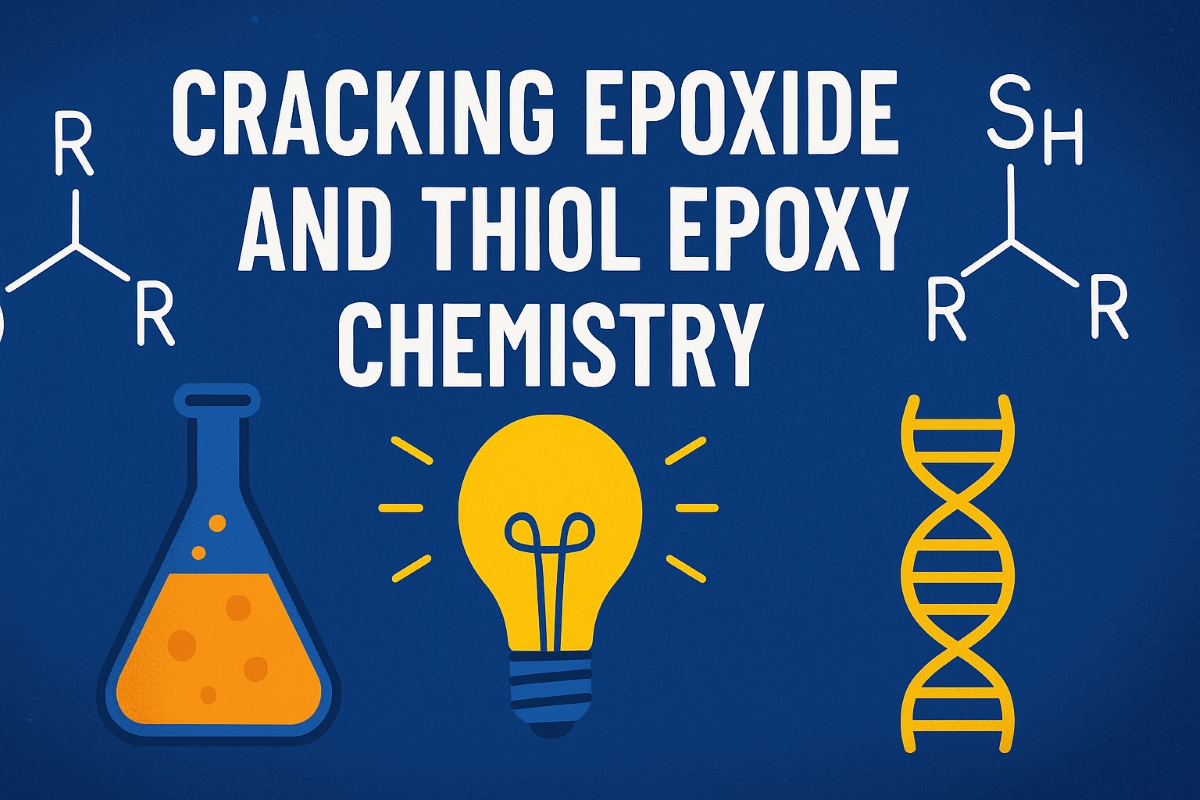Epoxide and thiol epoxy chemistry is a cornerstone of modern materials science, combining precision reaction control with practical performance. Whether you’re engineering high-performance adhesives or transparent coatings, the reaction between thiols and epoxides delivers unmatched versatility. This chemistry falls under the umbrella of “click reactions”—clean, modular, and highly efficient bond-forming processes with minimal byproducts.
🧬 What Are Epoxides and Thiols?
Epoxides (also called oxiranes) are three-membered cyclic ethers with significant ring strain. This strain renders them highly reactive in ring-opening reactions with nucleophiles.
Thiols contain a sulfur-hydrogen (-SH) group, making them potent nucleophiles under the right conditions.
The combination of these two species—particularly under catalysis—produces β-hydroxythioethers, a key linkage in many high-performance materials.
⚗️ Reaction Mechanisms: How Thiol-Epoxide Chemistry Works
- Base-Catalyzed Ring Opening: Thiols are deprotonated by a base to form thiolate anions. These strong nucleophiles attack the least-substituted carbon of the epoxide ring via SN2.
- Acid-Catalyzed Ring Opening: The epoxide oxygen is protonated, making the ring more electrophilic. Thiols attack under these acidic conditions but less efficiently.
- Photoinitiated Curing: Light triggers latent catalysts, initiating thiol-epoxide ring opening via radical or ionic mechanisms—ideal for precise control.
📊 The Role of Stoichiometry in Thiol-Epoxide Networks
| Stoichiometry | Resulting Property |
|---|---|
| 1:1 (Balanced) | High crosslink density, thermoset rigidity, excellent transparency |
| Excess Epoxide | Higher modulus, more brittleness, increased Tg |
| Excess Thiol | Lower crosslinking, increased elasticity, lower Tg |
🏭 Industrial Applications of Thiol-Epoxy Chemistry
- Electronics: Encapsulation, potting, and UV-resins for microfabrication.
- Medical Devices: Biocompatible gels, injectable adhesives, tissue scaffolds.
- Adhesives & Coatings: UV-curable, fast-drying, high-performance surfaces.
- Dental: Thermally stable, low-shrinkage composites for fillings and repairs.
🧪 Case Study: UV-Curable Optical Adhesives
A 1:1 PETMP + DGEBA system cured with UV light achieved:
- Full cure in under 15 seconds
- Glass transition temperature > 80°C
- > 95% transparency
- Tensile strength over 20 MPa
Such adhesives are ideal for LED encapsulation, OLEDs, and flexible photovoltaics.
☣️ Safety and Handling Considerations
| Hazard | Concern | Recommendation |
|---|---|---|
| Volatile thiols | Strong odor, skin irritation | Use in fume hood, wear gloves |
| Epoxide monomers | Skin and respiratory sensitizer | Handle with PPE and ventilation |
| Catalysts | Corrosive, irritant | Store safely, avoid skin contact |
🔬 Comparisons to Other Systems
| System | Curing Speed | Transparency | Shrinkage | Control Type |
|---|---|---|---|---|
| Thiol-Epoxy | Fast | High | Low | Base or UV |
| Amino-Epoxy | Slow | Opaque | Moderate | Heat |
| Thiol-Ene | Very Fast | Medium | Medium | UV or Radical |
🧠 Deeper Dive: Reaction Thermodynamics and Efficiency
Thiol-epoxy reactions are exothermic, releasing heat during curing. While this helps in propagation, excess heat in bulk curing may require mitigation to avoid cracking or voids.
Compared to isocyanate-based systems, thiol-epoxies offer lower toxicity, lower sensitivity to humidity, and better ambient reactivity, making them safer and easier to use in flexible environments.
🔬 Common Catalysts and Their Behavior
| Catalyst Type | Mechanism | Use Case |
|---|---|---|
| Tertiary Amine (e.g., TEA) | Base-catalyzed thiolate formation | Room temperature curing |
| Imidazoles | Dual acid/base catalysis | Fast, controlled industrial settings |
| Photolatent Bases | UV-triggered deprotonation | On-demand curing, 3D printing |
🏗️ Additional Industrial Applications
- 3D Bioprinting: Injectable and light-curable thiol-epoxy hydrogels are used for biological scaffolds in regenerative medicine.
- Smart Packaging: UV-cured thiol-epoxy coatings resist moisture and enhance shelf life for food and electronics.
- Renewable Energy: Used in wind turbine blades for their lightweight, high-strength, low-shrinkage profiles.
❓ Frequently Asked Questions (FAQs)
Q1: Is thiol-epoxy chemistry environmentally safe?
Yes—especially when bio-based reactants are used. No VOCs, fast curing, and high efficiency make it greener than traditional systems.
Q2: Can I use thiol-epoxy systems at home?
Yes. Some craft and electronics repair kits use these systems for quick-setting, low-odor adhesives. Still, wear gloves and ventilate.
Q3: What’s the difference between epoxy resins and thiol-epoxy systems?
Traditional epoxies require hardeners and heat. Thiol-epoxies cure faster, often at room temp or with light, and offer more precision tuning.
🔍 Conclusion
Thiol-epoxy chemistry combines science, speed, and strength. It’s the go-to for next-gen materials that must perform across biomedical, electronics, automotive, and green-tech sectors. As sustainability and precision grow in demand, so will this versatile reaction system.
🌍 Smart Materials and Sustainable Innovation
In recent years, the demand for smart and adaptive materials has skyrocketed, and epoxide and thiol epoxy chemistry is at the center of this transformation. From flexible electronics that respond to user movements, to bio-sensing platforms that detect changes in the human body, the versatility of this chemistry is opening new doors across research labs and commercial markets. The low shrinkage, quick curing, and high mechanical integrity offered by thiol-epoxy reactions make them ideal for creating next-generation polymers that need to be both responsive and durable. Moreover, their ability to work under room temperature and UV-controlled settings makes them energy-efficient, supporting global sustainability efforts.
🧪 The Future of Nanocomposites and Engineering
Another growing frontier where epoxide and thiol epoxy chemistry shines is in nanocomposite development. Scientists are now combining nano-fillers like graphene, silica, and carbon nanotubes with thiol-epoxy networks to enhance conductivity, thermal stability, and structural performance. These hybrid materials are being used in aerospace components, advanced medical implants, and even smart textiles. As industries look for greener, high-performance alternatives to traditional resins and hardeners, this reaction system offers the perfect blend of reliability and innovation. The future looks bright for epoxide and thiol epoxy chemistry—not only for what it can do today but for how it continues to evolve alongside modern engineering needs.

